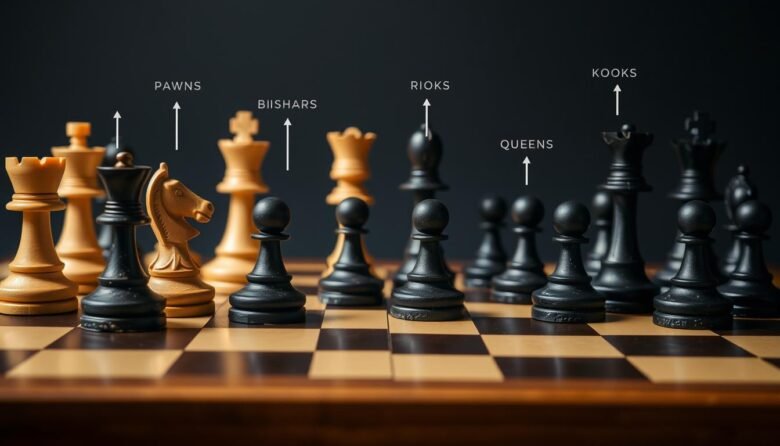Chess notation is key in the chess world. It gives players a way to record moves and make gameplay easy to read. This guide shows why knowing notation is important. It helps players talk about the game and analyze past games.
Learning chess notation is more than just a skill. It helps players think better and play better. It’s a way to get better at chess.
What is Chess Notation?
Chess notation is a way to record and analyze moves in a game. It helps players understand their games better. It also lets them study famous matches.
Definition and Purpose
Chess notation accurately documents each move. It helps players review their games or study others. There are different methods, like algebraic and descriptive systems, to make it clear and efficient.
Historical Background
The history of chess notation is long and has changed a lot. In the 19th century, descriptive notation was common. Later, the chess world moved to algebraic notation for a clearer way to communicate.
Types of Chess Notation
Learning about chess notation is key for anyone wanting to get better at the game. Each notation system has its own benefits and suits different players and analysts. Here are the main types of chess notation used today.
Algebraic Notation
Algebraic notation is the modern go-to for chess. It uses letters and numbers to record moves. Pieces are shown by their first letter, and squares by coordinates. This makes it easy to learn and use, letting players focus on strategy.
Descriptive Notation
Descriptive notation was once popular but is now less used. It describes moves from each player’s perspective. For example, a move might be written as “Queen to King’s Bishop 4.” While it’s clear, it’s not as common as algebraic notation today.
Other Notation Systems
There are more chess notation systems out there. Figurine notation uses symbols for pieces, and Forsyth-Edwards Notation (FEN) is for computers and publications. Each has its own role in the chess world.
Understanding Algebraic Notation
Algebraic notation is a way to write down and understand chess moves. It uses letters and numbers to show where pieces are on the board. Knowing this system helps players share their strategies more clearly.
Standard Moves
In algebraic notation, each piece is shown by a letter: R for rook, K for king, Q for queen, B for bishop, and N for knight. Pawns are shown by the lack of a letter. The board has 64 squares, from a1 to h8.
Moving a rook to a4 is written as Ra4. Captures are marked with an x. For example, a knight capturing a piece on c5 is Nxc5.
Special Symbols and Abbreviations
Knowing chess symbols and abbreviations is key for clear communication. Here are some important ones:
- x – Shows a capture (e.g., Nxc5).
- + – Means a check on the opponent’s king (e.g., Qh5+).
- ++ – Shows checkmate (e.g., Qh5++).
- O-O – Means kingside castling.
- O-O-O – Means queenside castling.
Knowing these symbols makes it easier to read and write down games. It helps players understand the game better.
How to Read Chess Notation
Learning to read chess notation is key for players who want to analyze games well. It lets players follow a game’s progress or look back at past matches. Getting familiar with chess notation examples helps grasp the game’s details.
Interpreting Moves
Starting with chess notation means knowing piece abbreviations and square coordinates. Each move shows a piece’s action, like moving to a new square or capturing an opponent’s piece. For example, “Nf3” means a knight goes to f3, and “exd5” shows a pawn capturing a piece on d5. Mastering these basics helps in accurately reading chess moves.
Common Examples
Many chess notation examples show common patterns. “O-O” means castling kingside, and “O-O-O” is for queenside. Pawn promotion is shown as “e8=Q” for a queen. Understanding these helps players improve their chess notation skills and gameplay.
Writing Chess Moves Using Notation
Learning to write chess moves is key for improving your game. Knowing step-by-step chess notation helps you record and analyze your strategies. This guide will help you start documenting your chess moves with ease.
Step-by-Step Guide
To write chess moves, follow a simple method. Here’s how:
- Get to know the board coordinates. Each piece and square has a unique identifier.
- Identify the piece being moved. Use letters like K for King, Q for Queen, and so on.
- State the destination square by its coordinate, like e4 or h5.
- Use special notations for certain moves. For example, “x” for captures and “O-O” for castling.
- Include the move number if it’s a timed game. This helps track the sequence.
Tips for Beginners
Starting out, beginners need tips to get better at chess notation. Here are some helpful tips:
- Start with simple positions to build your confidence.
- Look at notation examples often. Visuals help a lot.
- Write down games you play against friends or online. It helps you get better.
- Use chess software or apps that show notation. They’re very helpful.
- Be patient and keep practicing. You’ll get better with time.
Importance of Notation in Chess Strategy
Chess notation is key in strategy, helping players document their games. It makes understanding moves clear and aids in tracking game progress. It also helps in detailed chess game analysis.
By using proper notation, players can look back at their games. They can spot patterns and plan better for the future.
Tracking Game Progress
Keeping a record of moves lets players see how the game unfolds. They can spot important changes in the game’s flow. Chess notation is vital here, showing key moments and trends.
With this insight, players can make smarter choices in future games.
Analyzing Past Games
Chess notation is not just for playing games. It’s also great for analyzing past games. Players can find their mistakes and successes by reviewing games.
It lets them replay scenarios and learn from tactical errors. This self-review helps players grow and get better.
Software and Tools for Chess Notation
Today, chess players have many tools to help them record and analyze games. Thanks to technology, there are many digital programs and apps for chess. These tools help both new and experienced players learn notation.
Digital Notation Programs
Some digital programs are very popular in the chess world. ChessBase is known for its ability to note games, analyze positions, and study past matches. Arena and Scid let players manage game databases and use notation well, for both hobbyists and pros.
These tools make it easier to record games and dive deep into strategy analysis.
Chess Apps with Notation Features
Chess apps are key for players who want notation on their phones. Apps like Lichess and Chess.com have easy-to-use interfaces for recording games. They offer interactive play and learning through notation tools.
Many apps let you share games with friends, boosting the chess community’s spirit.
Common Mistakes in Chess Notation
In chess notation, many mistakes can make communication and analysis hard. Players often struggle with misinterpreting moves or finding inconsistencies in recording. Knowing and fixing these problems can help document games better.
Misinterpretation of Moves
Misunderstanding symbols and terms in chess notation is a big issue. New players might mix up similar notations, leading to wrong game records. It’s important to know each symbol’s meaning well to avoid these mistakes.
Inconsistencies in Recording
When players don’t use a standard way to record games, it can cause confusion. This makes it hard to understand the game’s flow during analysis. Using a consistent method for recording moves can clear up these issues, making game records clear and accurate.
Conclusion: Mastering Chess Notation
Learning chess notation is key to improving at chess. It helps in analyzing games better, understanding strategies, and talking clearly with other players. As you go through tough positions and review games, you’ll see how important notation is. It’s not just a tool; it’s a must for mastering chess.
Benefits of Proficiency
Knowing chess notation well helps you review your games better. It connects theory and practice, letting you analyze each move deeply. This skill also makes talking about chess with others more productive. It makes learning and growing in the chess world richer.
Encouraging Practice and Engagement
Make notation practice a regular part of your chess routine. Use it at chess clubs or in casual games. This practice strengthens your understanding of notation and chess. It helps you reach your full potential and keeps you interested in improving.




